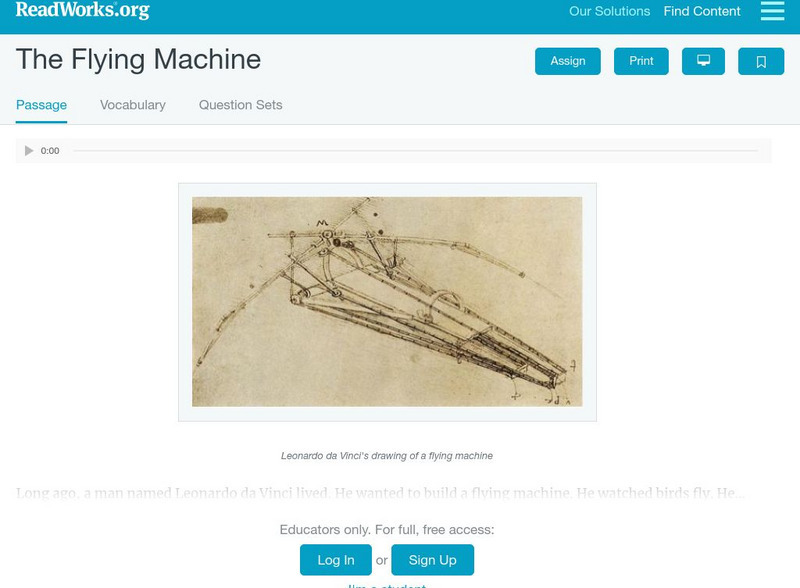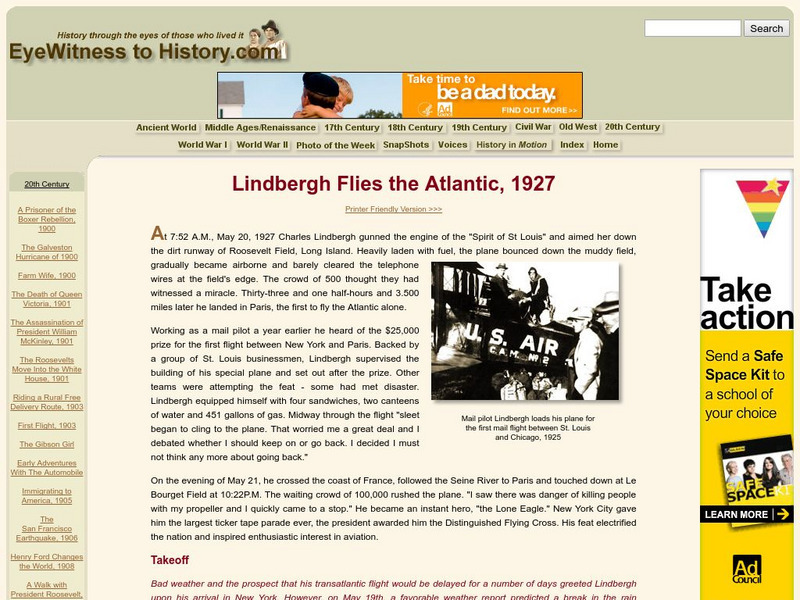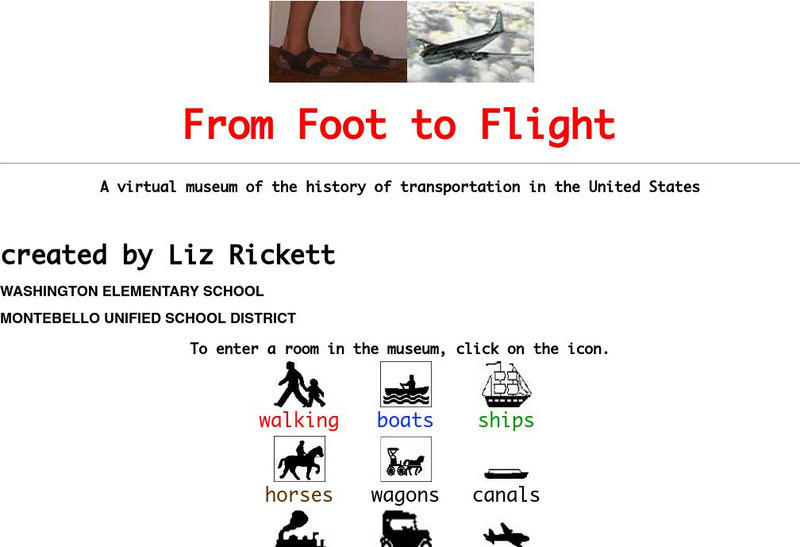NASA
Marshall Space Flight Center: Timeline of Rocket History
This graphical presentation includes a collection of more than 50 images and descriptions tracing rocketry from ancient times to the present day.
A&E Television
History.com: How Military Service Teams Dominated College Football During World War Ii
'Bear' Bryant, who became a legend at Alabama, and future Pro Football Hall of Famers were among the all-star collection of talent. With football fields viewed as proving grounds, the military fielded teams that competed against top...
Read Works
Read Works: The Flying Machine
[Free Registration/Login Required] This informational text passage gives a brief history of the airplane and ideas that came before the invention. This passage is a stand-alone curricular piece that reinforces essential reading skills...
Khan Academy
Khan Academy: Copley, a Boy With a Flying Squirrel (Henry Pelham)
John Singleton Copley (1738-1815) is commonly considered the greatest portrait painter in the history of the American colonies. Read about his background and view pictures of his portraits in this essay.
A&E Television
History.com: On 9/11, Some Evacuated the Pentagon but Kept Going Back Inside
'We pledge to never leave a fallen comrade behind,' says one of the survivors. American Airlines Flight 77, struck the Pentagon between Wedges 1 and 2. Anderson was in Wedge 2. Pentagon workers who had evacuated were trying to get inside...
A&E Television
History.com: 5 Terrifying Moments During the Apollo 11 Moon Landing Mission
The astronaut crew had to troubleshoot a series of problems throughout the historic 1969 flight. This historic exchange on July 20, 1969 marked the end of a perilous journey to the lunar surface, but a multitude of threats still faced...
A&E Television
History.com: How Many Times Has the u.s. Landed on the Moon?
Among seven Apollo moon landing missions, only one did not land men on the moon. Apollo 11 lunar module on July 20, 1969 to become the first human being to step foot on the moon. "That's one small step for man, one giant leap for...
Read Works
Read Works: Designing the First Flying Machine
[Free Registration/Login Required] An informational text about Wilbur and Orville Wright designing the first airplane. A question sheet is available to help students build skills in reading comprehension.
Famous Scientists
Famous Scientists: Alberto Santos Dumont
Read about Brazilian aviation pioneer, Alberto Santos-Dumont, who designed, built, and flew hot air balloons, and was famous for his flight that rounded the Eiffel Tower.
Smithsonian Institution
Smithsonian Learning Lab: Stories of the Wrights' Flights
This lesson plan has students read primary materials from the Smithsonian collection written by the Wright brothers, and compare and contrast them to secondary sources, such as newspaper stories from the next day. There is background...
NPR: National Public Radio
Npr: Evolution of Military Aviation
An interactive timeline lets you see examples of military aircraft that have evolved since the first flight of the Wright brothers. Links at the bottom of the page lead to articles about fighter pilots.
TeachEngineering
Teach Engineering: Will It Fly?
In this lesson, students will learn about kites and gliders and how these models can help in understanding the concept of flight. Students will design and build their own balsa wood models and experiment with different control surfaces....
A&E Television
History.com: 6 Little Known Pioneers of Aviation
From an early glider experimenter to the first man to fly solo around the world, here are six lesser-known pilots and inventors who made their mark on aviation.
TES Global
Blendspace: Taking Flight Trailblazers in History
A learning module with twenty-seven links to images, websites, texts, graphic organizers, and a quiz about people who have taken flight or invented flying machines throughout history.
Smithsonian Institution
Nat. Air and Space Museum: Pioneers of Flight: Rockets and Dream of Spaceflight
Read about the history of rocketry and the first rocket inventors who laid the initial foundation for the development of the spaceflight industry.
PBS
Freedom: A History of Us: A Plane Flight and a Great Crash
Read a brief description of the attempts to cross the Atlantic in a plane in the 1920s, ending with information about the successful trans-Atlantic flight of Charles Lindbergh.
American Museum of Natural History
American Museum of Natural History: Pterosaurs O Logy Card
OLogy cards are like virtual baseball cards about all kinds of science topics. This one is about ancient flying reptiles called pterosaurs. See if you can answer a few questions when you're done reading.
Other
Eaa Aviation Center: The B 17 Flying Fortress
Meet the B-17 "Flying Fortress," a World War II airplane. Take the interactive tour. Discover the history, photographs, testimonials, videos to watch, and views of the interior of the plane.
Ibis Communications
Eye Witness to History: Lindbergh Flies the Atlantic, 1927
Information on Lindbergh's historic flight in 1927.
9/11 Memorial & Museum
National September 11 Memorial & Museum: The Heroes of Flight 93 [Pdf]
The National September 11 Memorial & Museum has partnered with the New York City Department of Education and the New Jersey Commission on Holocaust Education to develop a robust set of 9/11 lessons for K-12 classrooms. Each lesson is...
9/11 Memorial & Museum
National September 11 Memorial & Museum: The Heroes of Flight 93 [Pdf]
The National September 11 Memorial & Museum has partnered with the New York City Department of Education and the New Jersey Commission on Holocaust Education to develop a robust set of 9/11 lessons for K-12 classrooms. Each lesson is...
Schools of California Online Resources for Education
Score: Washington Elementary School: From Foot to Flight
The history of transportation in the United States is at the click of the mouse for specific modes. Activities and glossary are included. Geared toward primary students in content and navigation.
Other
History Today: The Hindenburg Disaster and the End of the Airship Era
Article describing the history of the Hindenburg, with videos of it in flight and of it crashing.
Smithsonian Institution
National Air and Space Museum: Wright Brothers: Embracing the Impossible [Pdf]
In this lesson, students explore primary resources to see what people who lived in the early age of flight felt about this innovation. They then compare that response to that towards an invention of today.














